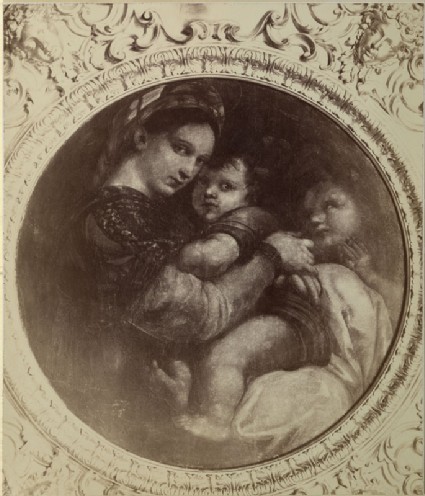Browse: 1470 objects
- Reference URL
Actions
Photograph of Raphael's "Madonna della Sedia" Anonymous Italian
-
Curator’s description:
Description
The round painting is surrounded by a deeply-carved gilt frame. The Virgin is shown half-length, sitting in a chair, holding Christ on her thigh and embracing him. Behind the Virgin's knee are the head and the hands of the young Saint John the Baptist.
Cook and Wedderburn (XXI.25 n. 2) call this a 'Photograph ... of Raphael's "Madonna della Seggiola," in the Pitti Palace, Florence' - in other words, the picture now known as the "Madonna della Sedia" (the "Madonna of the Chair"), painted by Raphael c.1514 and still in the Pitti Palace.
The photograph is first recorded in the Teaching Collection in the "Catalogue of Examples" of 1870, when Ruskin listed it in frame no. 37 of the Standard Series, below a photograph of Bellinil's "Madonna degli Alberetti"; both works retained their positions in the 1872 catalogue of the series.
Ruskin was not a great admirer of Raphael: in his Florentine diary of 1845, he called this painting 'a clever, well-finished, vulgar, piece of maternity, very uncopiable' (IV.85 n. 1). As with the previous pair of works in the series, the portraits attributed to Mantegna and by Raphael in frame no. 36, Ruskin intended this as a comparison to the detriment of Raphael. Here, although he asked his students to compare the conception of the works rather than their execution as in the preceding example, Bellini's north Italian work (what Ruskin called 'Lombard'), was again judged superior. Ruskin made a similar point in his 'Verona' catalogue (no. 50 = XIX.458), where the same comparison showed 'the first transition from the style of the "Masters" to that of modern times'. Likewise, in his "Lectures on Art" (§ 183 = XX.172-173) - referring back to the 'Verona' catalogue - Ruskin described how art had declined since Bellini's time: 'the love of their gods and their country had contracted itself now into that of their domestic circle, which was little more than the halo of themselves. ... Bellini's Madonna cares for all creatures through her child; Raphael’s, for her child only.' In "Modern Painters" (vol. II, pt. iii, sec. 1, ch. 5, § 10 = IV.84-85), he describes the use of a plain dark background, in place of the open sky of Raphael's earlier small Madonnas, as symbolising Raphael's betrayal of the faith he had received from his father (Giovanni Santi) and his master (Perugino).
Elsewhere in the "Lectures on Art" (§ 55 = XX.62-63), Ruskin described the "Madonna della Sedia" as a typical example of a religious work which takes as its starting-point the appearances of real people, who are then modified; he considered that 'There is hardly any great art which entirely belongs to this class'. In "Modern Painters" (vol. III, pt iv, ch. 4, §§ 12-14 = V.77-79) he described how this was part of a tendency whereby 'religious facts were employed for the display of art': 'The appearances of nature were more closely followed in everything; and the crowned Queen-Virgin of Perugino sank into a simple Italian mother in Raphael’s Madonna of the Chair.' This was to be deplored, because greater truth to nature was adopted not for religious reasons, but for artistic ones - rather than painting in a spirit of religious adoration, the artist was considering his subject merely as an opportunity to display his facility in solving artistic problems.
-
Details
- Artist/maker
-
Anonymous Italian (Anonymous, Italian) (photographer)after Raphael (1483 - 1520)
- Object type
- photograph
- Material and technique
- albumen print
- Dimensions
- 223 x 188 mm
- Inscription
- On the back of the mount:
on the left edge, towards the bottom, in graphite: St. 37 lower
to the right, the Ruskin School's stamp
- Provenance
-
Presented by John Ruskin to the Ruskin Drawing School (University of Oxford), 1875; transferred from the Ruskin Drawing School to the Ashmolean Museum, c.1949.
- No. of items
- 1
- Accession no.
- WA.RS.STD.037.b
-
Subject terms allocated by curators:
Subjects
-
References in which this object is cited include:
References
Ruskin, John, Catalogue of Examples Arranged for Elementary Study in the University Galleries (Oxford: Clarendon Press, 1870), cat. Standard no. 37
Ruskin, John, Catalogue of the Reference Series Including Temporarily the First Section of the Standard Series (London: Smith, Elder, [1872]), cat. Standard no. 37
Ruskin, John, ‘Drawings and Photographs, Illustrative of the Art of Verona, Shown at the Royal Institution, Feb. 4th 1870’, Edward T. Cook and Alexander Wedderburn, eds, The Works of John Ruskin: Library Edition, 39 (London: George Allen, 1903-1912), 19, no. 50 = XIX.458
Ruskin, John, ‘The Works of John Ruskin’, Edward T. Cook and Alexander Wedderburn, eds, The Works of John Ruskin: Library Edition, 39 (London: George Allen, 1903-1912)
Ruskin, John, ‘The Ruskin Art Collection at Oxford: Catalogues, Notes and Instructions’, Edward T. Cook and Alexander Wedderburn, eds, The Works of John Ruskin: Library Edition, 39 (London: George Allen, 1903-1912), 21, cat. Standard no. 37
Ruskin, John, ‘Lectures on Art: Delivered Before the University of Oxford in Hilary Term, 1870’, Edward T. Cook and Alexander Wedderburn, eds, The Works of John Ruskin: Library Edition, 39 (London: George Allen, 1903-1912), 20
Ruskin, John, ‘Modern Painters’, Edward T. Cook and Alexander Wedderburn, eds, The Works of John Ruskin: Library Edition, 39 (London: George Allen, 1903-1912), 3-7
Location
-
- Western Art Print Room
Position in Ruskin’s Collection
Ruskin's Catalogues
-
Ruskin's Catalogue of Examples (1870)
37. Madonnas by John Bellini and Raphael.I wish you to compare the manner of conception in these two examples, as of execution in the preceding ones, the Lombardic masters having, I think, the advantage in both respects.
-
Ruskin's Standard & Reference series (1872)
37. Madonnas by John Bellini and Raphael.I wish you to compare the manner of conception in these two examples, as of execution in the preceding ones, the Lombardic master having, I think, the advantage in both respects.





